A Large Scale Benchmark of Person Re-Identification
Abstract
1. Introduction
2. Related Work
2.1. Standard ReID Datasets
2.2. Descriptor Learning in ReID
2.3. UAV Detection, Classification, and 3D Tracking Techniques
3. LSMS and LSMS-UAV Dataset
3.1. Overview of Previous ReID Datasets
3.2. Description to LSMS and LSMS-UAV
3.2.1. Description to LSMS
3.2.2. Description to LSMS-UAV
3.3. Evaluation Protocol
4. Classic ReID Algorithms
4.1. Bag of Tricks (BoT)
4.2. Part-Based Convolutional Baseline (PCB)
4.3. Pose-Driven Deep Convolutional (PDC)
5. Experiments
5.1. Typical Datasets
5.2. Implementation Details
5.3. Performance on LSMS and LSMS-UAV across Different Datasets
5.4. Performance on LSMS across Different Methods
6. Conclusions
Author Contributions
Funding
Data Availability Statement
Conflicts of Interest
References
- Xie, H.; Deng, T.; Wang, J.; Chen, W. Angular Tracking Consistency Guided Fast Feature Association for Visual-Inertial SLAM. IEEE Trans. Instrum. Meas. 2024, 73, 5006614. [Google Scholar] [CrossRef]
- Deng, T.; Liu, S.; Wang, X.; Liu, Y.; Wang, D.; Chen, W. ProSGNeRF: Progressive Dynamic Neural Scene Graph with Frequency Modulated Auto-Encoder in Urban Scenes. arXiv 2023, arXiv:2312.09076. [Google Scholar]
- Wang, Y.; Fan, Y.; Wang, J.; Chen, W. Long-term navigation for autonomous robots based on spatio-temporal map prediction. Robot. Auton. Syst. 2024, 179, 104724. [Google Scholar] [CrossRef]
- Ding, G.; Zhang, S.; Khan, S.; Tang, Z.; Zhang, J.; Porikli, F. Feature affinity-based pseudo labeling for semi-supervised person re-identification. IEEE Trans. Multimed. 2019, 21, 2891–2902. [Google Scholar] [CrossRef]
- Ding, G.; Khan, S.; Tang, Z.; Porikli, F. Feature mask network for person re-identification. Pattern Recognit. Lett. 2020, 137, 91–98. [Google Scholar] [CrossRef]
- Yin, Q.; Wang, G.A.; Wu, J.; Luo, H.; Tang, Z. Dynamic re-weighting and cross-camera learning for unsupervised person re-identification. Mathematics 2022, 10, 1654. [Google Scholar] [CrossRef]
- Zheng, L.; Shen, L.; Tian, L.; Wang, S.; Wang, J.; Tian, Q. Scalable person re-identification: A benchmark. In Proceedings of the IEEE International Conference on Computer Vision, Santiago, Chile, 7–13 December 2015; pp. 1116–1124. [Google Scholar]
- Liao, S.; Hu, Y.; Zhu, X.; Li, S.Z. Person re-identification by local maximal occurrence representation and metric learning. In Proceedings of the IEEE Conference on Computer Vision and Pattern Recognition, Santiago, Chile, 7–13 December 2015; pp. 2197–2206. [Google Scholar]
- Zhang, G.; Zhang, Y.; Zhang, T.; Li, B.; Pu, S. PHA: Patch-wise high-frequency augmentation for transformer-based person re-identification. In Proceedings of the IEEE/CVF Conference on Computer Vision and Pattern Recognition, Vancouver, BC, Canada, 17–24 June 2023; pp. 14133–14142. [Google Scholar]
- Li, W.; Zhao, R.; Xiao, T.; Wang, X. Deepreid: Deep filter pairing neural network for person re-identification. In Proceedings of the IEEE Conference on Computer Vision and Pattern Recognition, Zurich, Switzerland, 6–12 September 2014; pp. 152–159. [Google Scholar]
- Su, C.; Li, J.; Zhang, S.; Xing, J.; Gao, W.; Tian, Q. Pose-driven deep convolutional model for person re-identification. In Proceedings of the IEEE International Conference on Computer Vision, Venice, Italy, 22–29 October 2017; pp. 3960–3969. [Google Scholar]
- Wei, L.; Zhang, S.; Gao, W.; Tian, Q. Person transfer gan to bridge domain gap for person re-identification. In Proceedings of the IEEE Conference on Computer Vision and Pattern Recognition, Salt Lake City, UT, USA, 18–23 June 2018; pp. 79–88. [Google Scholar]
- Chen, W.; Xu, X.; Jia, J.; Luo, H.; Wang, Y.; Wang, F.; Sun, X. Beyond appearance: A semantic controllable self-supervised learning framework for human-centric visual tasks. In Proceedings of the IEEE/CVF Conference on Computer Vision and Pattern Recognition, Vancouver, BC, Canada, 17–24 June 2023; pp. 15050–15061. [Google Scholar]
- Luo, H.; Gu, Y.; Liao, X.; Lai, S.; Jiang, W. Bag of tricks and a strong baseline for deep person re-identification. In Proceedings of the IEEE/CVF Conference on Computer Vision and Pattern Recognition Workshops, Long Beach, CA, USA, 16–17 June 2019. [Google Scholar]
- Cheng, D.S.; Cristani, M.; Stoppa, M.; Bazzani, L.; Murino, V. Custom pictorial structures for re-identification. In Proceedings of the BMVC, Dundee, UK, 29 August–2 September 2011; Volume 1, p. 6. [Google Scholar]
- Hirzer, M.; Beleznai, C.; Roth, P.M.; Bischof, H. Person re-identification by descriptive and discriminative classification. In Image Analysis: Proceedings of the 17th Scandinavian Conference, SCIA 2011, Ystad, Sweden, 1 May 2011; Springer: Berlin/Heidelberg, Germany, 2011; pp. 91–102. [Google Scholar]
- Ristani, E.; Solera, F.; Zou, R.; Cucchiara, R.; Tomasi, C. Performance measures and a data set for multi-target, multi-camera tracking. In European Conference on Computer Vision; Springer International Publishing: Cham, Switzerland, 2016; pp. 17–35. [Google Scholar]
- Xiao, T.; Li, H.; Ouyang, W.; Wang, X. Learning deep feature representations with domain guided dropout for person re-identification. In Proceedings of the IEEE Conference on Computer Vision and Pattern Recognition, Las Vegas, NV, USA, 27–30 June 2016; pp. 1249–1258. [Google Scholar]
- Zheng, Z.; Zheng, L.; Yang, Y. Unlabeled samples generated by gan improve the person re-identification baseline in vitro. In Proceedings of the IEEE International Conference on Computer Vision, Venice, Italy, 22–29 October 2017; pp. 3754–3762. [Google Scholar]
- Zheng, Z.; Zheng, L.; Yang, Y. A discriminatively learned cnn embedding for person reidentification. ACM Trans. Multimed. Comput. Commun. Appl. (TOMM) 2017, 14, 1–20. [Google Scholar] [CrossRef]
- Geng, M.; Wang, Y.; Xiang, T.; Tian, Y. Deep transfer learning for person re-identification. arXiv 2016, arXiv:1611.05244. [Google Scholar]
- Hermans, A.; Beyer, L.; Leibe, B. In defense of the triplet loss for person re-identification. arXiv 2017, arXiv:1703.07737. [Google Scholar]
- Chen, W.; Chen, X.; Zhang, J.; Huang, K. Beyond triplet loss: A deep quadruplet network for person re-identification. In Proceedings of the IEEE Conference on Computer Vision and Pattern Recognition, Honolulu, HI, USA, 21–26 July 2017; pp. 403–412. [Google Scholar]
- Yin, Q.; Ding, G.; Gong, S.; Tang, Z. Multi-view label prediction for unsupervised learning person re-identification. IEEE Signal Process. Lett. 2021, 28, 1390–1394. [Google Scholar] [CrossRef]
- Wu, S.; Chen, Y.C.; Li, X.; Wu, A.C.; You, J.J.; Zheng, W.S. An enhanced deep feature representation for person re-identification. In Proceedings of the 2016 IEEE Winter Conference on Applications of Computer Vision (WACV), Lake Placid, NY, USA, 7–10 March 2016; pp. 1–8. [Google Scholar]
- Wei, L.; Zhang, S.; Yao, H.; Gao, W.; Tian, Q. Glad: Global-local-alignment descriptor for pedestrian retrieval. In Proceedings of the 25th ACM International Conference on Multimedia, Mountain View, CA, USA, 23–27 October 2017; pp. 420–428. [Google Scholar]
- Insafutdinov, E.; Pishchulin, L.; Andres, B.; Andriluka, M.; Schiele, B. Deepercut: A deeper, stronger, and faster multi-person pose estimation model. In Proceedings of the Computer Vision—ECCV 2016: 14th European Conference, Amsterdam, The Netherlands, 11–14 October 2016; Part VI 14. pp. 34–50. [Google Scholar]
- Zhao, H.; Tian, M.; Sun, S.; Shao, J.; Yan, J.; Yi, S.; Tang, X. Spindle net: Person re-identification with human body region guided feature decomposition and fusion. In Proceedings of the IEEE Conference on Computer Vision and Pattern Recognition, Honolulu, HI, USA, 21–26 July 2017; pp. 1077–1085. [Google Scholar]
- Li, D.; Chen, X.; Zhang, Z.; Huang, K. Learning deep context-aware features over body and latent parts for person re-identification. In Proceedings of the IEEE Conference on Computer Vision and Pattern Recognition, Honolulu, HI, USA, 21–26 July 2017; pp. 384–393. [Google Scholar]
- Jaderberg, M.; Simonyan, K.; Zisserman, A. Spatial transformer networks. In Proceedings of the Advances in Neural Information Processing Systems, Montreal, QC, Canada, 7–12 December 2015; Volume 28. [Google Scholar]
- Liu, T.; Cai, Q.; Xu, C.; Zhou, Z.; Ni, F.; Qiao, Y.; Yang, T. Rumor Detection with a novel graph neural network approach. arXiv 2024, arXiv:2403.16206. [Google Scholar] [CrossRef]
- Yao, A.; Jiang, F.; Li, X.; Dong, C.; Xu, J.; Xu, Y.; Liu, X. A novel security framework for edge computing based uav delivery system. In Proceedings of the 2021 IEEE 20th International Conference on Trust, Security and Privacy in Computing and Communications, Shenyang, China, 20–22 October 2021; pp. 1031–1038. [Google Scholar]
- Tong, K.W.; Wu, J.; Hou, Y.H. Robust Drogue Positioning System Based on Detection and Tracking for Autonomous Aerial Refueling of UAVs. IEEE Trans. Autom. Sci. Eng. 2023. [Google Scholar] [CrossRef]
- Wang, C.Y.; Bochkovskiy, A.; Liao, H.Y.M. YOLOv7: Trainable bag-of-freebies sets new state-of-the-art for real-time object detectors. In Proceedings of the IEEE/CVF Conference on Computer Vision and Pattern Recognition, Vancouver, BC, Canada, 17–24 June 2023; pp. 7464–7475. [Google Scholar]
- Liu, R.; Xu, X.; Shen, Y.; Zhu, A.; Yu, C.; Chen, T.; Zhang, Y. Enhanced Detection Classification via Clustering SVM for Various Robot Collaboration Task. arXiv 2024, arXiv:2405.03026. [Google Scholar]
- Liu, T.; Xu, C.; Qiao, Y.; Jiang, C.; Yu, J. Particle Filter SLAM for Vehicle Localization. arXiv 2024, arXiv:2402.07429. [Google Scholar]
- Ru, J.; Yu, H.; Liu, H.; Liu, J.; Zhang, X.; Xu, H. A Bounded Near-Bottom Cruise Trajectory Planning Algorithm for Underwater Vehicles. J. Mar. Sci. Eng. 2022, 11, 7. [Google Scholar] [CrossRef]
- Weng, Y. Big data and machine learning in defence. Int. J. Comput. Sci. Inf. Technol. 2024, 16, 25–35. [Google Scholar] [CrossRef]
- Lan, X.; Ye, M.; Zhang, S.; Yuen, P. Robust collaborative discriminative learning for RGB-infrared tracking. In Proceedings of the AAAI Conference on Artificial Intelligence, New Orleans, LA, USA, 2–7 February 2018; Volume 32. [Google Scholar]
- Liu, J.; Wang, G.; Jiang, C.; Liu, Z.; Wang, H. Translo: A window-based masked point transformer framework for large-scale lidar odometry. In Proceedings of the AAAI Conference on Artificial Intelligence, Washington, DC, USA, 7–14 February 2023; Volume 37, pp. 1683–1691. [Google Scholar]
- Gray, D.; Tao, H. Viewpoint invariant pedestrian recognition with an ensemble of localized features. In Proceedings of the Computer Vision—ECCV 2008: 10th European Conference on Computer Vision, Marseille, France, 12–18 October 2008; Part I 10. pp. 262–275. [Google Scholar]
- Ren, S.; He, K.; Girshick, R.; Sun, J. Faster R-CNN: Towards real-time object detection with region proposal networks. IEEE Trans. Pattern Anal. Mach. Intell. 2016, 39, 1137–1149. [Google Scholar] [CrossRef]
- He, K.; Zhang, X.; Ren, S.; Sun, J. Deep residual learning for image recognition. In Proceedings of the IEEE Conference on Computer Vision and Pattern Recognition, Las Vegas, NV, USA, 27–30 June 2016; pp. 770–778. [Google Scholar]
- Sun, Y.; Zheng, L.; Yang, Y.; Tian, Q.; Wang, S. Beyond part models: Person retrieval with refined part pooling (and a strong convolutional baseline). In Proceedings of the European Conference on Computer Vision, Munich, Germany, 8–14 September 2018; pp. 480–496. [Google Scholar]
- Yin, Q.; Wang, G.A.; Ding, G.; Li, Q.; Gong, S.; Tang, Z. Rapid Person Re-Identification via Sub-space Consistency Regularization. Neural Process. Lett. 2023, 55, 3149–3168. [Google Scholar] [CrossRef]
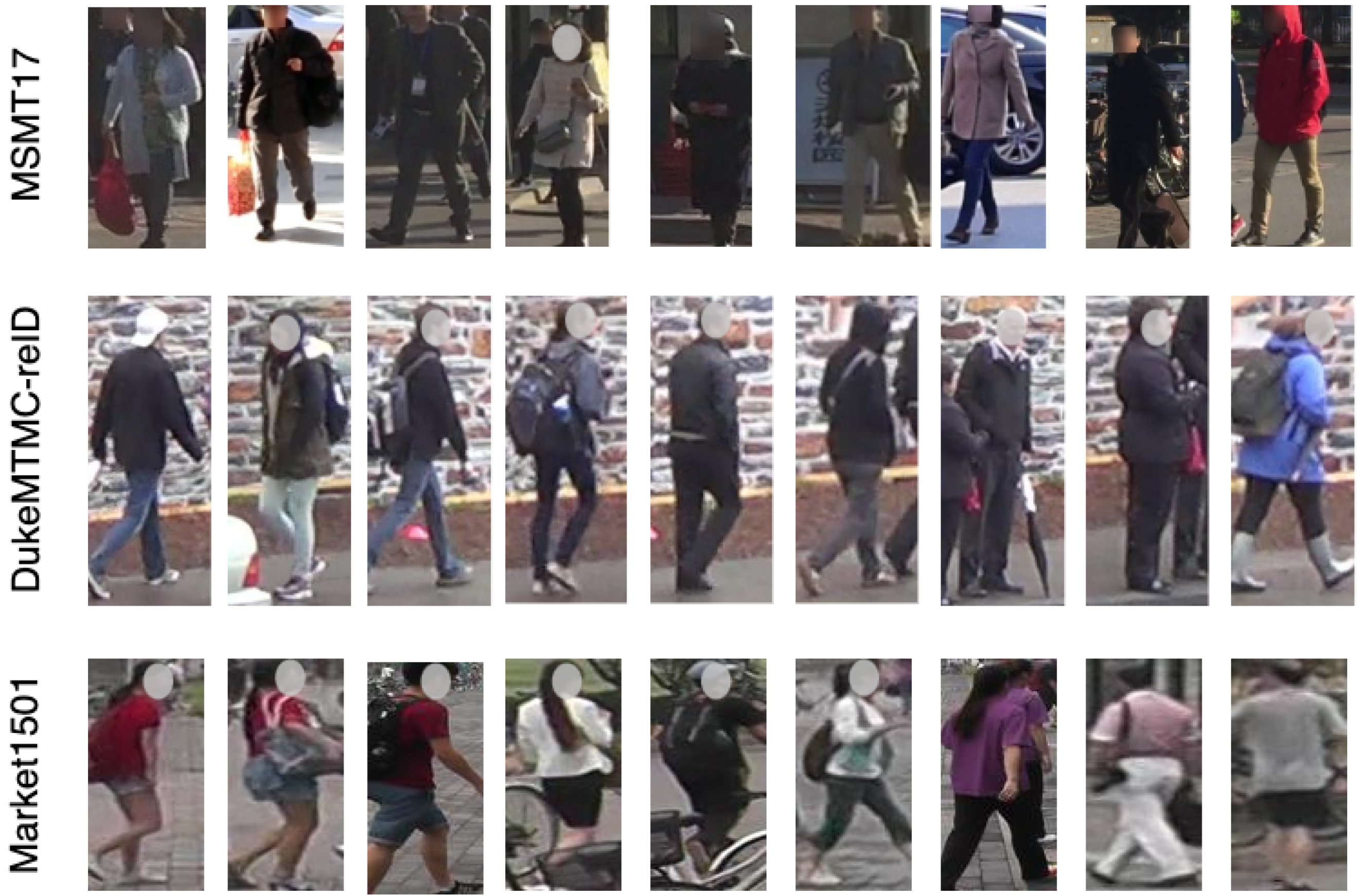
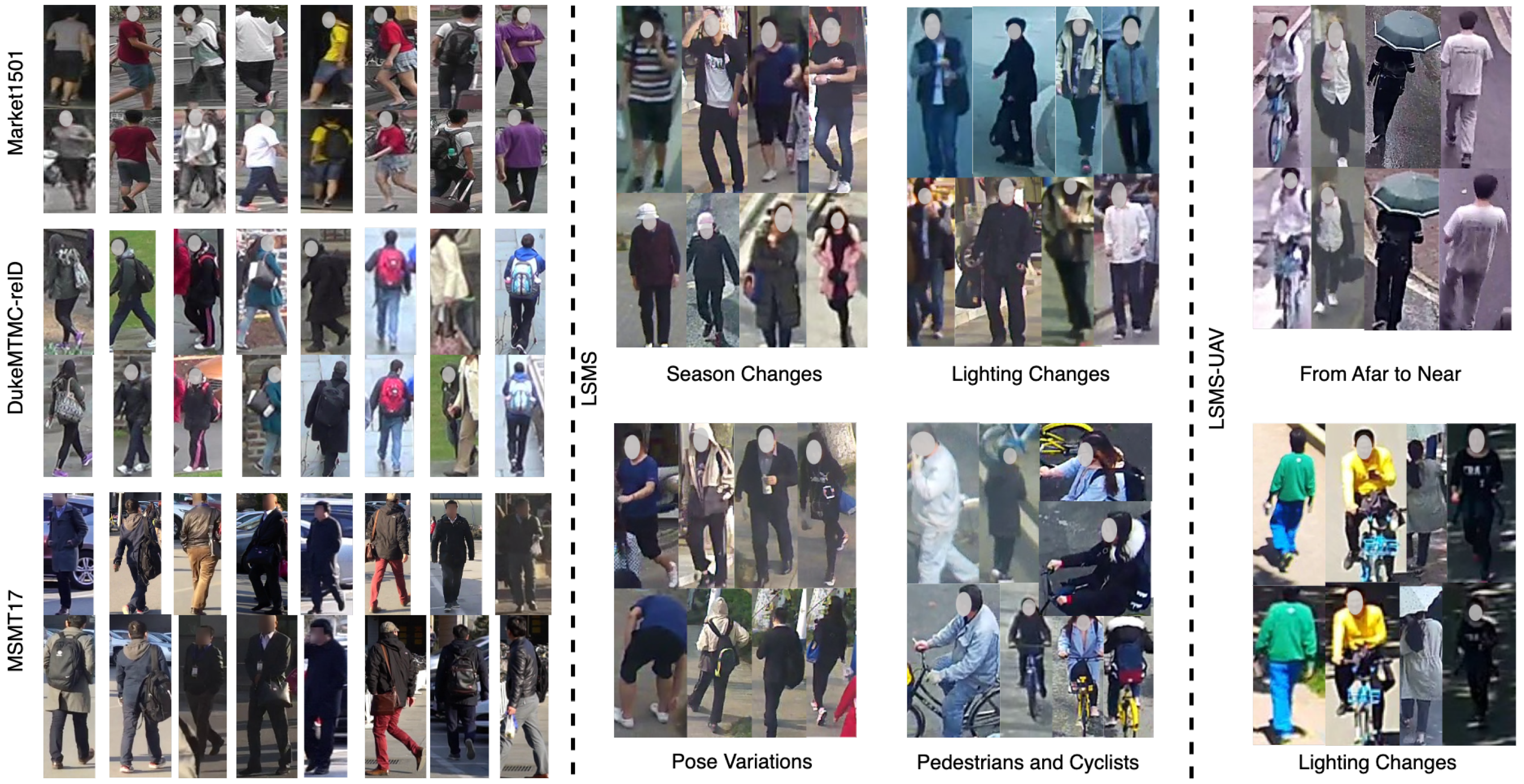

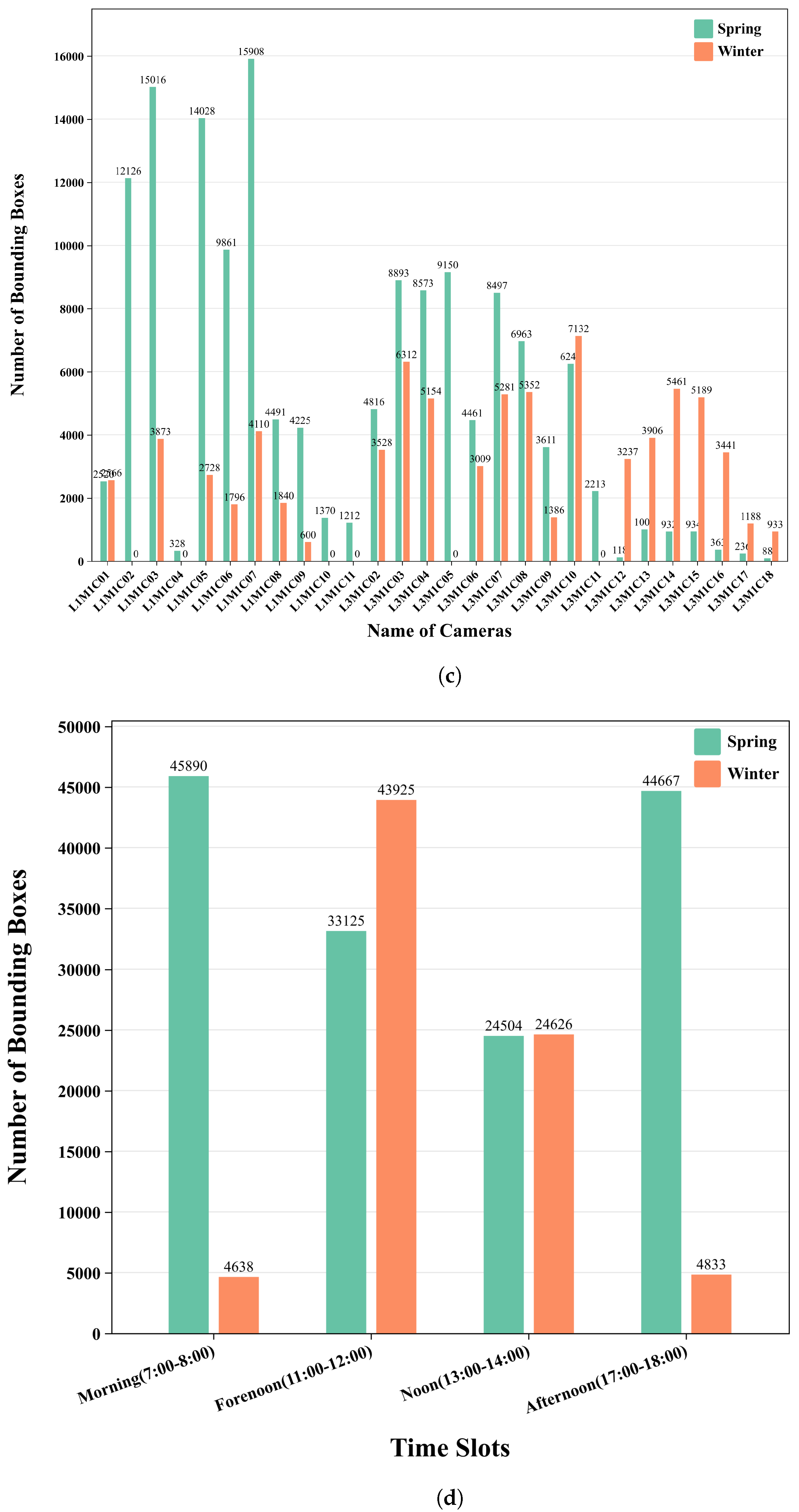
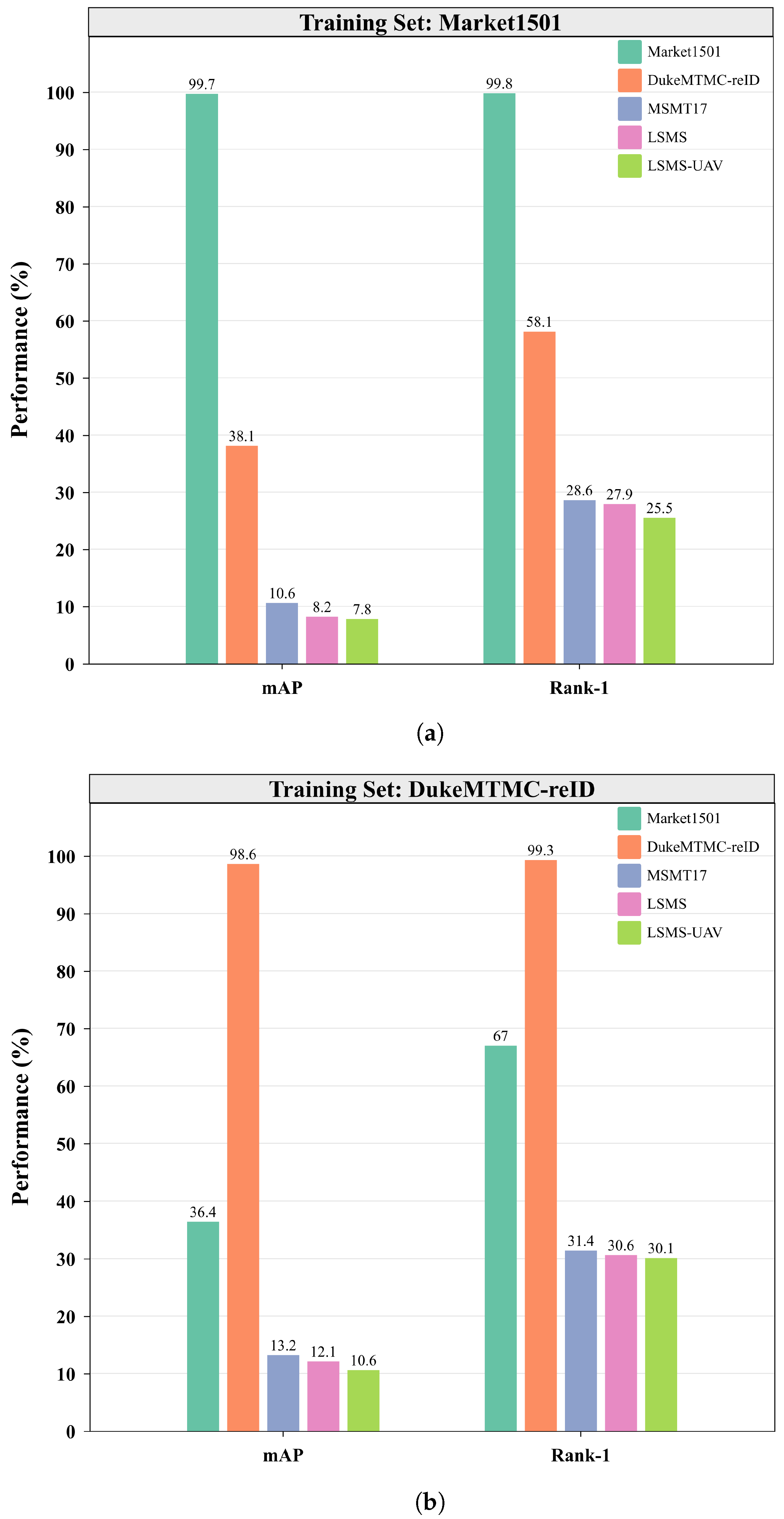
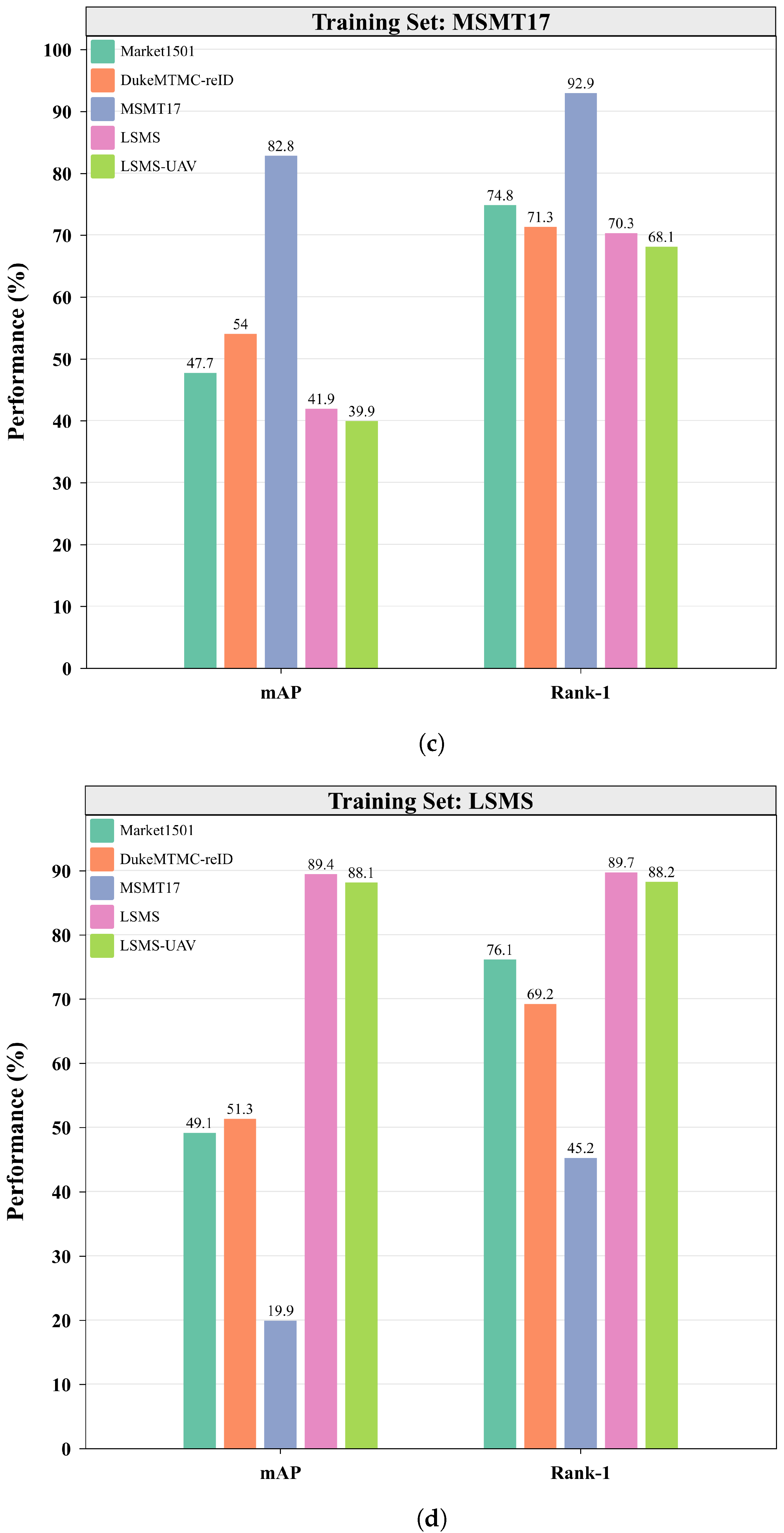
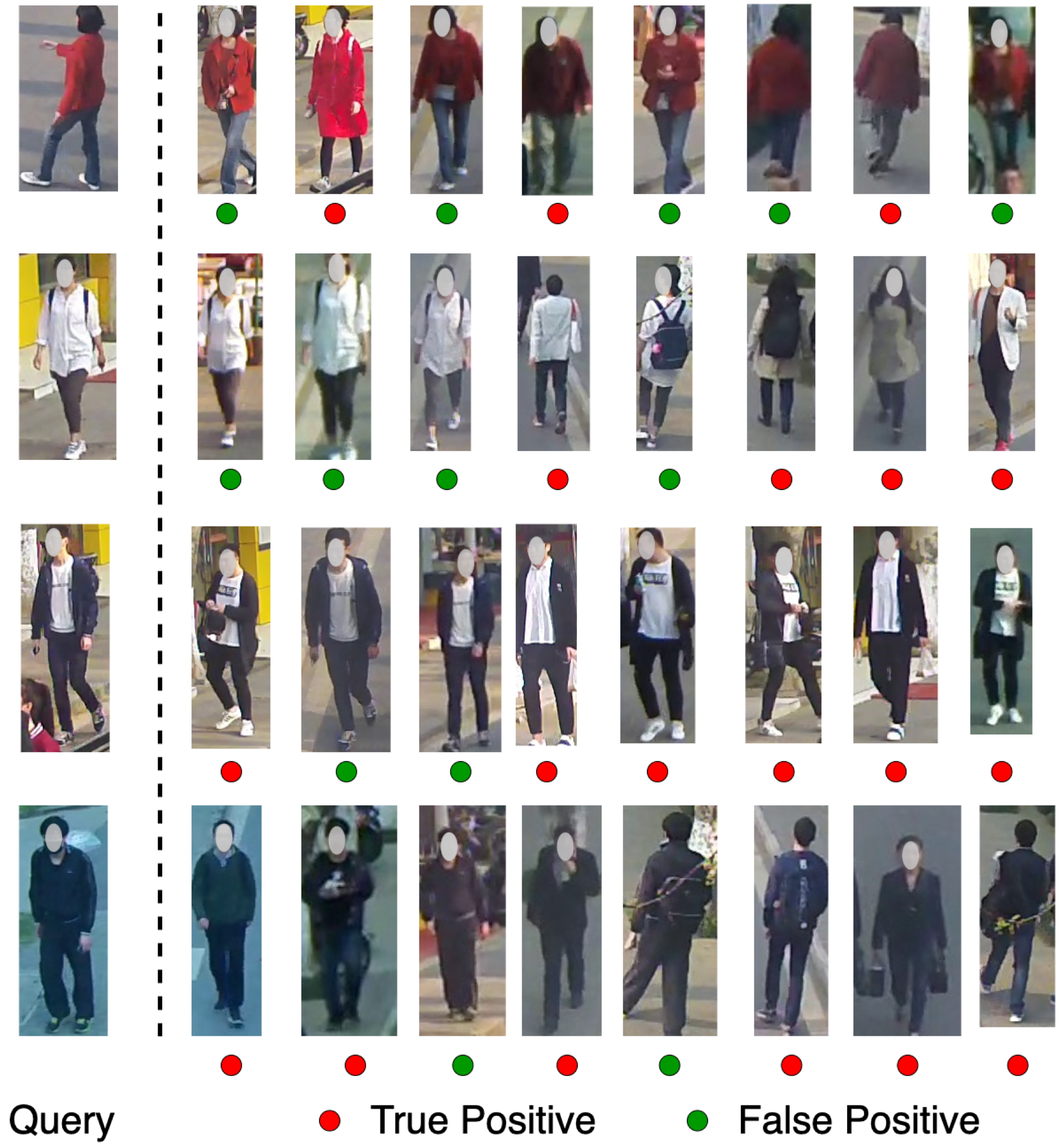
| Dataset | LSMS | MSMT17 [12] | DukeMTMC-ReID [17] | Market-1501 [7] | CUHK03 [10] | VIPeR [41] | PRID [16] | CAVIAR [15] |
|---|---|---|---|---|---|---|---|---|
| BBoxes | 286,695 | 126,441 | 36,411 | 32,668 | 28,192 | 1264 | 1134 | 610 |
| Identities | 7730 | 4101 | 1812 | 1501 | 1467 | 632 | 934 | 72 |
| Cameras | 29 | 15 | 8 | 6 | 2 | 2 | 2 | 2 |
| Detector | Faster RCNN | Faster RCNN | hand | DPM | DPM, hand | hand | hand | hand |
| Seasons | Spring | Winter | ||||
|---|---|---|---|---|---|---|
| Training | Testing | Training | Testing | |||
| Query | Gallery | Query | Gallery | |||
| Bboxes | 148,186 | 8511 | 30,466 | 78,022 | 3915 | 17,595 |
| Identities | 3869 | 1217 | 1217 | 1905 | 739 | 739 |
| Cameras | 28 | 27 | 27 | 22 | 22 | 23 |
| LSMS | Bounding Boxes | Identities |
|---|---|---|
| Training set | 226,208 | 5774 |
| Query set | 12,426 | 1956 |
| Gallery set | 48,061 | 1956 |
| LSMS-UAV | Bounding Boxes | Identities |
|---|---|---|
| Query set | 500 | 500 |
| Gallery set | 1500 | 500 |
Disclaimer/Publisher’s Note: The statements, opinions and data contained in all publications are solely those of the individual author(s) and contributor(s) and not of MDPI and/or the editor(s). MDPI and/or the editor(s) disclaim responsibility for any injury to people or property resulting from any ideas, methods, instructions or products referred to in the content. |
© 2024 by the authors. Licensee MDPI, Basel, Switzerland. This article is an open access article distributed under the terms and conditions of the Creative Commons Attribution (CC BY) license (https://creativecommons.org/licenses/by/4.0/).
Share and Cite
Yin, Q.; Ding, G. A Large Scale Benchmark of Person Re-Identification. Drones 2024, 8, 279. https://doi.org/10.3390/drones8070279
Yin Q, Ding G. A Large Scale Benchmark of Person Re-Identification. Drones. 2024; 8(7):279. https://doi.org/10.3390/drones8070279
Chicago/Turabian StyleYin, Qingze, and Guodong Ding. 2024. "A Large Scale Benchmark of Person Re-Identification" Drones 8, no. 7: 279. https://doi.org/10.3390/drones8070279
APA StyleYin, Q., & Ding, G. (2024). A Large Scale Benchmark of Person Re-Identification. Drones, 8(7), 279. https://doi.org/10.3390/drones8070279






